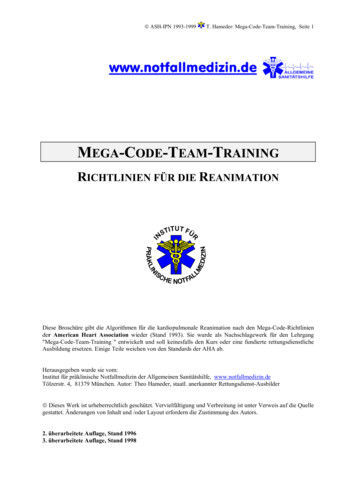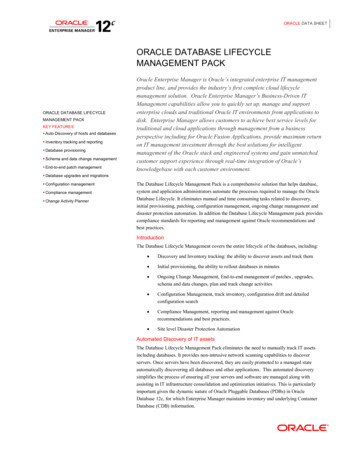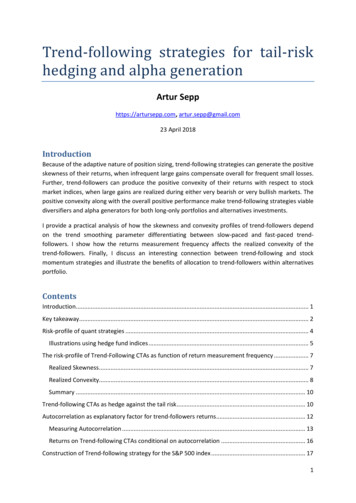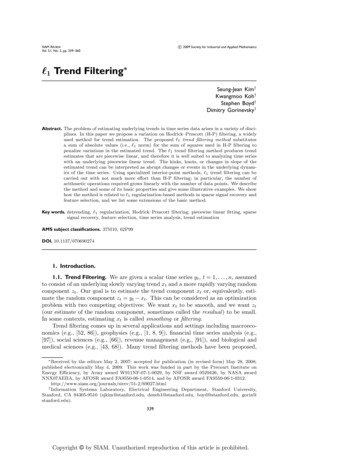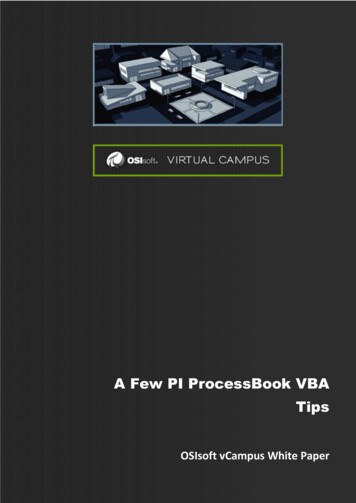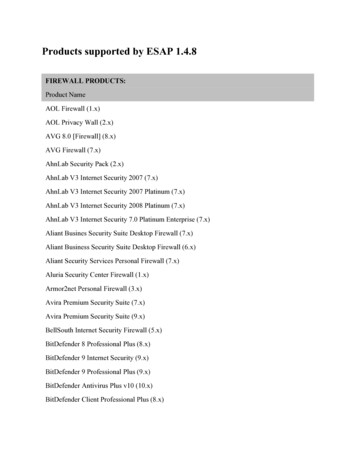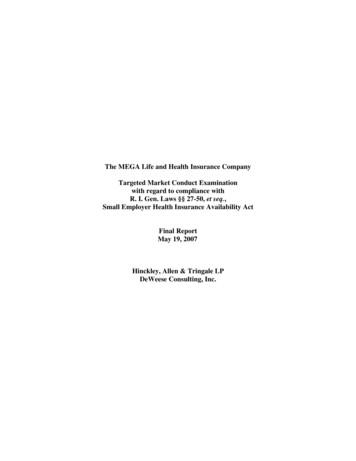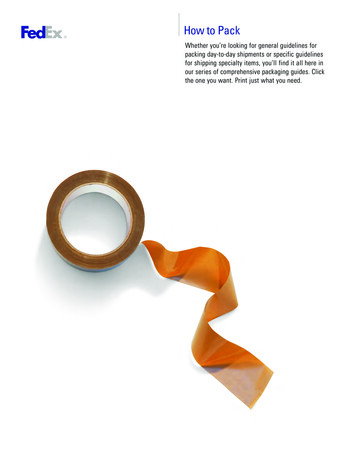
Transcription
How to PackWhether you’re looking for general guidelines forpacking day-to-day shipments or specific guidelinesfor shipping specialty items, you’ll find it all here inour series of comprehensive packaging guides. Clickthe one you want. Print just what you need.
ContentsClick the guide you want.General Packaging Guidelines3Packaging Perishable Shipments8Packaging Flowers and Plants16Packaging Computer Shipments20Packaging Clinical Samples26Packaging UN 3373 Shipments30Automotive and Mechanical Parts34Packaging Battery Shipments42
General Packaging GuidelinesAt FedEx, we know proper packaging can helpensure that your shipments arrive safely. Sowe offer general packaging guidelines — frommeasuring and weighing your package, to packingmethods, sealing and labeling instructions, andguidelines for restricted shipments.ContentsShipment Size and Weight Restrictions4General Packaging Guidelines4General Packing Methods5Sealing Your Package6Addressing and Labeling Your Package6Packaging Specialty Shipments6Back to How to Pack contents
Shipment Size and Weight RestrictionsCalculating Dimensional Weight W ith FedEx Express U.S. services, you can shippackages up to 150 lbs.; up to 119" in length and 165"in length and girth.Dimensional weight applies when your package isrelatively light compared with its volume. If thedimensional weight exceeds the actual weight,charges based on the dimensional weight will beassessed. To calculate it: ith FedEx Express international services, you can Wship packages up to 150 lbs.; up to 108" in length and130" in length and girth. ith FedEx Express Freight Services, you can ship Windividual skids of 150 lbs. or more. Skids exceeding2,200 lbs. in weight or exceeding 70" in height, 119"in length or 80" in width require prior approval. W ith FedEx Ground services, you can ship packagesup to 150 lbs.; up to 108" in length and 165" in lengthplus girth. W ith FedEx Home Delivery services, you can shippackages up to 70 lbs.; up to 108" in length and 165"in length plus girth. Place yellow and black safety heavyweight labels over thediagonal corners of your package if it weighs more than75 lbs. To get the labels, contact your FedEx Express courieror FedEx account executive, or go to a FedEx Office Print& Ship CenterSM or FedEx World Service Center .Measuring Length and Girth ivide by 194 (for U.S. and Puerto Rico shipments) Dor 166 (for international shipments). Compare the dimensional weight and actual weight.General Packaging Guidelines U se FedEx Express packaging for FedEx Expresspackage shipments only; any other use is prohibited. Y ou may use your own packaging if boxes are sturdyand undamaged with all flaps intact. C hipboard boxes, such as gift or shoe boxes, must bepacked into a corrugated outer box. Use double-wall boxes for heavier items. P lace small packages inside a larger outer box. Forexpress shipments smaller than 7" x 4" x 2", usea FedEx Express packaging option. D ouble-box fragile items with 3" of cushioning in andaround the smaller box.Length and Girth FormulaGirth is(2 x width) (2 x height) W rap items individually with cushioning materialand center them in cartons away from other itemsand away from the sides, corners, top and bottom ofthe box. P osition bottles that contain liquids upright. Use aninner seal and perforated breakaway cap. The innerpackaging must be able to contain leaks.HeightWidthLengthLength is the longest side of the package or object.The length and girth formula is simple. Here’s what you do: Measure the length, height and width of the package. L ength and girth equals length plus twice the widthand twice the height.Back to contents Multiply length by width by height in inches. P lace items that might be damaged by normalhandling, such as soiling, marking or application ofadhesive labels, in a protective outer box. F or odd- or irregular-shaped items, at a minimum youshould wrap and tape all sharp edges or protrusions. E nclose an extra label, business card or letterheadwith the shipper’s address and phone number andthe recipient’s address and phone number inside thepackage before sealing it. R emove all old address labels from reused boxesbefore shipping, and make sure there are no holes,tears or corner dents in the outer box.Page 4
General Packing MethodsBox-in-Box Packing MethodFollow these general guidelines for the two mostpopular packing methods, plus recommendations forodd or irregular-shaped shipments. rap product(s) individually with at least 2" thickness Wof air-cellular cushioning or foam material to fit snuglyinside a corrugated box.Single-Box Packing Method S hip nonfragile products like soft goods inside asturdy outer box. U se fillers like crumpled newspaper, loosefill peanutsor air-cellular cushioning material to fill void spacesand prevent movement of goods inside the boxduring shipping. P lace goods that might be affected by dirt, water orwet conditions inside a plastic bag. C onsolidate small parts or spillable granular productsin a strong sealed container, such as a burlap orsiftproof plastic bag, then package in a sturdyouter box. Use the H taping method for sealing your package.Single-Box Illustration With Wrapped ItemProduct wrappedin a minimum 3"thickness ofcushioning material R estrict product movement inside the box using fillerlike crumpled newspaper, loosefill peanuts or othercushioning material. C lose and tape the inner box using the H tapingmethod. This will help prevent accidental opening. U se a second box that is at least 6" longer, wider anddeeper than the inner box. C hoose the wrap or fill method to cushion the innerbox inside the larger sturdy outer box. S hip fragile products individually, wrapping them ina minimum 3" thickness of air-cellular cushioningmaterial such as Bubble Wrap . rap the inner box with 3" thickness of air-cellular Wcushioning material or use at least 3" of loosefillpeanuts or other cushioning material to fill the spacesbetween the inner box and outer box on the top,bottom and all sides. Fill any void spaces with more cushioning material. Use the H taping method for sealing your package.Box-in-Box Illustration With Loosefill PeanutsSturdyouter boxPacking material(e.g., loosefill peanuts)minimum of 2" thicknesson each sideInner boxSingle-Box Illustration Filled With Loosefill PeanutsNonfragile productwith cushioningto prevent movementPacking material(e.g., loosefillpeanuts) minimumof 3" thicknesson each sideSturdyouter boxSturdyouter boxBack to contentsPage 5
Box-in-Box Illustration With Air-Cellular CushioningSmaller inner boxwrapped in 3"of air-cellularcushioning material P ackage labels and packing slips should be appliedfacing the same direction on the same side ofthe package. void wrapping labels around the corner or directly on Athe edge or seam of the package. P lace shipping labels on the package’s largestsurface. While we cannot ensure compliance withmarkings such as “Up” arrows or “This End Up,”properly placing the shipping label increases yourchance for the preferred orientation.Sturdy outerbox, measuring6" larger onall sides U se tie-on tags on transit cases (including tradeshowdisplay cases), golf bags, skis and luggage.Sealing Your PackageUse applicable routing label,airbill or address label U se pressure-sensitive plastic tape, water-activatedpaper tape (minimum 60-lb. grade) or water-activatedreinforced tape that is at least 2" wide. A pply tape evenly across flaps and seams to both the topand bottom of the outer box. Use the H taping method. D o not use cellophane tape, duct tape, masking tape,string or rope to seal packages.H taping methodPackaging Specialty ShipmentsSome shipments require detailed instructions for properpackaging to ensure intact delivery to your destination.We suggest that you download those stand-alone PDFfiles in their entirety. Guidelines for packaging specialtyitems contain specific packing, sealing, labeling and testinginstructions. You’ll find specific guidelines for those products in the table of contents. Recommendations for itemsthat don’t require such specific guidelines follow.Addressing and Labeling Your Package P lace delivery information inside and outsidethe package. Include an address for your recipientand yourself. D o not list a P.O. box address for U.S. recipients. FedExExpress can ship to a P.O. box in certain internationallocations, including Puerto Rico, but you must provide avalid telephone, fax or telex number. R emove or cross out any old address labels onthe outer box.Back to contentsPage 6
General Guidelines for Unique ItemsDangerous Goods Shipments via FedEx Express rtwork. Apply masking tape in a criss-cross pattern Aon the glass surface to prevent glass from splintering;call the FedEx packaging hotline at 1.800.633.7019 fora list of artwork-packaging manufacturers.Dangerous goods must be tendered to FedEx Expressaccording to both current IATA regulations for airtransport and the FedEx Express Terms and Conditions. P hotos and Posterboard. Tape flat items ontoa rigid material like plywood, plastic or layers offiberboard padding; as an alternative, place printedmaterial between pieces of corrugated pad and tapeboth pads together at all seams. U ndeveloped Film. Prominently mark packagescontaining undeveloped film. Special labelsare available. Ask your FedEx courier or call1.800.GoFedEx 1.800.463.3339 (say “ordershipping supplies”). S tringed Musical Instruments. Loosen the tensionon the strings to remove the stress on the neck ofthe instrument. rinted Matter. Bundle printed material together to Pprevent shifting. Cushion sufficiently before packinginto a double-walled corrugated outer box. olled Goods. Tightly wrap rolled goods using Rseveral layers of heavy-duty plastic film or Kraftpaper and wrap with plastic packing tape. Thenwrap the address label completely around the objector use a pouch. FedEx cannot assume liability fordamage due to inadequate protection.Address labelBar-code labelIf you have other questions, call the FedEx DangerousGoods/Hazardous Materials hotline at 1.800.GoFedEx1.800.463.3339 (say “dangerous goods”).To find updated dangerous goods guidelines, informationon packaging guidelines and other information,go to fedex.com/us/services/options, then selectDangerous Goods. You can also register at ars.htmlfor IATA/ICAO training that meets government-mandatedtraining under 49 Code of Federal Regulations (49CFR)172.700. To speak with a dangerous goods shippingprofessional, call 1.800.GoFedEx 1.800.463.3339 (say“dangerous goods”).Hazardous Materials Shipments via FedEx GroundIf you haven’t shipped hazardous materials via FedExGround before, contact your FedEx account executivefirst. We need to confirm that you’ve met governmenttraining requirements and can generate thedocumentation your shipment needs.To find updated hazardous materials guidelines,information on packaging guidelines and otherinformation, go to fedex.com/us/services/options,then select Hazardous Materials. To register for onlinetraining that meets DOT certification requirements, go towww.shipsafeshipsmart.com or call 1.800.762.3744,ext. 6753. To speak with a hazardous materials shippingprofessional, call 1.800.GoFedEx 1.800.463.3339 (say“dangerous goods”).Protective wrapBubble Wrap is a registered trademark of Sealed Air Corporation.NOTICE: This packaging brochure is provided to FedEx customers to help reduce loss or damage due to improper packaging. It is NOT intended to be a comprehensive guide for packaging items weaccept for transit. We make no warranties, expressed or implied, regarding this information. Proper packaging is the sole responsibility of the shipper. For more information and additional guidelines, goto the packaging tips page on fedex.com/packaging , e-mail packagingservices@fedex.com or contact FedEx Packaging Services at 1.800.633.7019. Refer to the current FedEx Service Guide for terms,conditions and limitations applicable to FedEx delivery services. 2010 FedEx. All rights reserved.Back to contentsPage 7
Packaging Perishable ShipmentsTo help prevent spoilage and maintain product integrity,follow these instructions for shipping your perishable itemsvia FedEx Express services.ContentsPreparing Perishable Items for Shipment9How to Keep Products Refrigerated During Transit10How to Keep Products Frozen During Transit11Shipping Seafood With Wet Ice13How to Protect Products From Freezing13Sealing and Labeling Instructions14The FedEx Express Transportation Environment14FedEx Package Testing and Design Services14Contacts and Resources15Back to How to Pack contents
Preparing Perishable Items for ShipmentPerishable products may be subjected to harshenvironmental conditions, such as excessive temperatureor humidity, on the way to their destination. We do notprovide temperature-controlled shipping services forexpress shipments. However, with careful packaging,you can protect your products by providing appropriatetemperature protection or stability.During shipping, insulation and refrigerants are key topreserving products like seafood, plants, meat and fruitsas well as dairy, medical and chemical products. Withthe proper combination of insulation and refrigerants,you can maintain products within specific temperatureranges. You can keep products frozen, or preventproducts from freezing. You can prevent melting andthawing in hot weather and minimize the effects ofshort-term temperature variations. We’ll show you how.InsulationWe recommend insulation to reduce the transfer of heatthrough packaging container walls. The most commoninsulation materials are expanded polystyrene (EPS)foam, rigid polyurethane foam and reflective materials(radiant barrier films).RefrigerantsWe recommend refrigerants such as gel coolants and dryice* to keep perishable products cold or frozen. However,do not use dry ice as a refrigerant for live seafood suchas lobsters; use gel coolants instead. Wet ice has manydisadvantages, including weight and special waterresistant packaging requirements, but it may be usedif properly prepared to prevent leakage. Use insulated foam containers with a minimum of1-1/2"-thick walls. Bag perishable products that can melt or thaw, orshipments that contain liquid, using minimum 2-milwatertight plastic bags. Place foam containers inside sturdy outer containers. Include the address and 24-hour phone number of boththe shipper and the recipient on each shipping label.Express Service Recommendations We recommend that perishables be shipped via FedExFirst Overnight , FedEx Priority Overnight , FedExStandard Overnight or FedEx 1Day Freight. The maximum acceptable gross weight per package formost FedEx Express overnight services is 150 lbs.,including packaging and refrigerant. For overnight shipment of packages with a grossweight of 151 to 2,200 lbs. each, use FedEx1Day Freight. We recommend that you package perishables for aminimum transit time of 30 hours. FedEx does not recommend shipping perishables viaFedEx 2Day , FedEx 2Day Freight or FedEx ExpressSaver , but if you choose to you should packageshipments for at least 12 hours more than thedelivery commitment time. Avoid shipment of perishable items on days that willrequire transit on a weekend or over a holiday period. Perishable seafood items are acceptable for shipmentswithin the U.S. only.General Guidelines for Packaging Perishables Package shipments to withstand handling indifferent orientations. Use a refrigerant that will keep products within therequired temperature range. Use gel coolants forrefrigerating products between 32 F (0 C) and 60 F(16 C). Use dry ice* for frozen items.* Dry ice (carbon dioxide solid, UN 1845) is considered a dangerous good/hazardous material for air transport and requires special handling. See DryIce Shipping Regulations for details.Back to contentsPage 9
How to Keep Products RefrigeratedDuring TransitGel coolants are preferable to wet ice. Freeze the coolants according to themanufacturer’s guidelines. Precool the insulated container, if possible. If your shipment contains liquid or perishable productsthat could contain liquids, double-bag the productsusing minimum 2-mil watertight plastic bags and linethe inside of the foam container with a minimum 2-milplastic liner and absorbent material. Arrange products inside the insulated container,allowing space for coolants. Place a sufficient number of coolants on top of andaround the product. Fill all void space with dunnage such as loosefillpeanuts to prevent product movement. Close the liner bag securely. Place the insulated container inside a corrugatedouter box. Close and securely seal the corrugated box withpressure-sensitive plastic tape. Apply the tape overall box flaps and seams.Packaging Perishable Shipments With Gel CoolantsBag Closure InstructionsTwist end of bag tightly.Fold over.Wrap rubber bandsecurely around fold-overto ensure closure.Packaging Seafood Shipments With Gel CoolantsExpandedpolystyrenefoam cooler topCoolantProper fold-overbag closureSeafood*2-mil sealedplastic bag(double-bagged)2-mil sealedplastic bagInsulated container lidCoolantProduct2-mil plastic linerInsulated containerCoolantAbsorbent padsExpandedpolystyrenefoam coolerbottomOuter corrugated boxOutercorrugatedbox* When shipping live edible seafood (lobsters, oysters, crabs), use gelcoolants and follow the same packaging steps except do not seal the bags.Back to contentsPage 10
How to Keep Products FrozenDuring Transit Freeze products before packaging. Precool the insulated container, if possible. If the shipment contains liquid or perishable productsthat can melt or thaw, bag the products or line theinsulated container using a minimum 2-mil watertightplastic bag. When arranging products inside the insulatedcontainer, allow enough space for dry ice. Place a sufficient amount of dry ice in the insulatedcontainer on top of and around the products. Fill void spaces with dunnage material such asloosefill peanuts. Close the liner bag (if used) but do not completelyseal it, as the carbon dioxide gas created by the dry icemust be allowed to vent. Place the lid on the insulated container. Place the insulated container inside an outercorrugated box. Close and securely tape the box with pressuresensitive plastic tape. Apply tape to all flapsand seams. Complete the required paperwork, dangerous goodslabeling and markings.Dry Ice Shipping RegulationsDry ice (or carbon dioxide solid, UN 1845) is considereda dangerous good/hazardous material for air transportand requires special handling. Shippers are also requiredto have function-specific dangerous goods training asoutlined in 49CFR (Code of Federal Regulations) 172.700.When shipping with dry ice, you must provide correctidentification, classification, markings and labeling onyour outer carton to comply with current requirementsin the International Air Transport Association (IATA)dangerous goods regulations.The following permanent markings are required on theouter packaging of all IATA dry ice shipments: “Dry Ice” or “Carbon Dioxide Solid.” “UN 1845.” Net weight of dry ice in kilograms. Name and address of the shipper. Name and address of the recipient.FedEx Dry Ice Label3ABC Food Company1234 Main StreetMemphis, TN 38112Liam Riley2020 Vision StreetAtlanta, GA 30305An IATA Class 9 Miscellaneous label must appear on all dryice shipments. FedEx Express offers a dry ice label that, whencorrectly completed, satisfies the IATA marking and labelingrequirements, available free of charge at fedex.com or bycalling 1.800.GoFedEx 1.800.463.3339.When dry ice changes to carbon dioxide gas in enclosedspaces like aircraft cargo holds, it displaces oxygen. Thedesign and construction of packaging used for dry iceshipments must prevent the buildup of pressure thatcould cause rupturing. Dry ice must never be placed inan airtight container.Back to contentsPage 11
Whether you use online shipment processing atfedex.com or a FedEx airbill, select “Dry Ice” on yourdocumentation and complete the dry ice information.In addition, mark “Yes, Shipper’s Declaration notrequired” in the Special Handling section on the airbill.If you have questions or need more information aboutdry ice shipments, call the FedEx Dangerous Goods/Hazardous Materials Hotline at 1.800.GoFedEx1.800.463.3339 (say “dangerous goods”).Additional Requirements for ShippingFrozen Seafood Double-bag seafood in minimum 2-mil plasticbags, with each bag individually sealed using thefold-over method. Place adequate absorbent material such as pads,cellulose wadding or paper towels in the bottom ofthe foam container to absorb any liquids.Packaging Frozen Seafood Shipments With Dry IceExpandedpolystyrenefoam cooler topPackaging Perishable Shipments With Dry IceInsulated container lidDry iceDry ice blocksProper fold-overbag closureProductSeafoodDry ice blocks2-mil sealedplastic bag(double-bagged)2-mil plastic linerInsulated containerDry iceOuter corrugated boxAbsorbent padsExpandedpolystyrenefoam coolerbottomDry ice labelOutercorrugatedboxDry icelabel Back to contentsPage 12
Shipping Seafood With Wet IceHow to Protect Products From FreezingFedEx does not recommend the use of wet ice (frozenwater) as a refrigerant. If you believe wet ice isnecessary, it must be prepared to prevent the leakageof any liquid, regardless of orientation. Double-bag seafood in minimum 2-mil plasticbags, with each bag individually sealed using thefold-over method. Double-bag the ice in minimum 2-mil plasticbags, with each bag individually sealed using thefold-over method. Line the insulated container using a minimum 2-milwatertight plastic bag. Place adequate absorbent material such as pads,cellulose wadding or paper towels in the bottom ofthe foam container to absorb any liquids. Follow all other packaging requirements forseafood shipments. Ship via FedEx Priority Overnight service only.You can help protect your products from lowtemperatures or freezing by using “heat sinks,” whichhelp maintain desired temperatures. Gel coolants makegood heat sinks. Place your products inside an insulated container andsurround them with room-temperature (about 72 F) gelcoolants to reduce the risk of freezing. Fill all void space with dunnage such as loosefillpeanuts to prevent product movement. Ship the insulated container inside a corrugated box.Packaging Seafood Shipments With Wet IceExpandedpolystyrenefoam cooler topIce in 2-mil sealedplastic bag(double-bagged)Packaging Perishables to Prevent FreezingInsulated container lidWarm coolantProduct2-mil plastic linerInsulated containerProper fold-overbag closureSeafood2-mil sealedplastic bag(double-bagged)Outer corrugated boxIce in 2-mil sealedplastic bag(double-bagged)Absorbent pads2-mil sealedplastic bagExpandedpolystyrenefoam coolerbottomOutercorrugatedboxBack to contentsPage 13
Sealing and Labeling Instructions Apply at least three strips of pressure-sensitiveadhesive plastic tape that is at least 2" wide to boththe top and bottom of the carton. Tape all seams or flaps using the H taping method. Place the shipping label on the top of thelargest surface. Mark your outer container “Perishable.”H taping methodWhile we cannotensure compliancewith markings suchas up arrows or“This End Up,”properly placing theshipping label increasesyour chance for thepreferred orientation.Dry ice label (when required).Dry ice (carbon dioxide solid,UN 1845) is considered a dangerousgood/hazardous material for air transportand requires special handling. See Dry IceShipping Regulations for details.The FedEx ExpressTransportation EnvironmentPerishable products must withstand various temperatureconditions in the FedEx Express shipping environment.The cargo areas of our vans and trucks are nottemperature-controlled, and temperature will varydepending on time of year, location, exposure tosunlight and other variables. In summer months thetemperature in the cargo area of ground vehicles canbe as much as 30 degrees Fahrenheit higher than theambient temperature outside the vehicle.On board FedEx Express aircraft, temperatures varydepending on the type of aircraft, the location of eachcargo compartment and the package location withineach compartment, the length of flight, and the cruisingaltitude. For general reference, temperatures aboardmost wide-body aircraft main cargo compartments varybetween 65 F (18 C) and 90 F (32 C). Packages positionedin the bulk department, next to the aircraft’s outerstructure, might be exposed to temperatures as low as0 F (-18 C) during flight.Back to contentsAir pressures on FedEx Express aircraft vary from aslow as 8.3 psi at cruise altitude to as much as 14.7 psion the ground.FedEx Package Testingand Design ServicesWe offer free package testing, evaluation and designservices that can help you predict packaging performanceand avoid product spoilage. We encourage you to submita sample of your perishables packaging for testingand evaluation.Testing Request GuidelinesFollow these steps for submitting your packaging fortesting. An active FedEx account number is required. Youand your FedEx account executive should expect testingresults via e-mail in approximately 5 to 7 business daysfrom FedEx Packaging Services’ receipt of your packaging.1. Obtain a FedEx Packaging Test Application atfedex.com/packaging or by contacting FedExPackaging Services at packagingservices@fedex.comor 1.800.633.7019.2. Complete and sign your application, referencing thename of your FedEx account executive on the form.See the FedEx Packaging Test Application for termsgoverning test or design.3. Prepare a sample test package including all thepackaging components and contents in the exactconfiguration you intend to send to your customer.4. Place your completed application, your sampletest package labeled “Test This Package” and anynecessary cushioning material in a sturdy outercontainer marked “Overpacked/Test Pkg. Inside.”5. Send your shipment to the address indicated on theFedEx Packaging Test Application.Page 14
Contacts and Resources How to Pack guidelines at fedex.com/packaging. FedEx Packaging Services lab,packagingservices@fedex.com or 1.800.633.7019. FedEx field packaging engineers,pkgfield@corp.ds.fedex.com, or contact yourFedEx account executive for a referral. FedEx Dangerous Goods/Hazardous MaterialsHotline, 1.800.GoFedEx 1.800.463.3339 (say“dangerous goods”).NOTICE: This packaging brochure is provided to FedEx customers to help reduce loss or damage due to improper packaging. It is NOT intended to be a comprehensive guide for packaging items weaccept for transit. We make no warranties, expressed or implied, regarding this information. Proper packaging is the sole responsibility of the shipper. For more information and additional guidelines, goto the packaging tips page on fedex.com/packaging, e-mail packagingservices@fedex.com or contact FedEx Packaging Services at 1.800.633.7019. Refer to the current FedEx Service Guide for terms,conditions and limitations applicable to FedEx delivery services. 2010 FedEx. All rights reserved.Back to contentsPage 15
Packaging Flowers and PlantsTo help ensure that your fresh flowers and live plants arrivein top condition, follow these instructions for packagingand shipping via FedEx Express services.ContentsPackaging Requirements17Preparing Flowers and Plants for Shipment17Express Service Recommendations18Sealing and Labeling Instructions19FedEx Package Testing and Design Services19Contacts and Resources19Back to How to Pack contents
Packaging RequirementsObserve the following general requirements whenpackaging your shipments: Secure contents inside the shipping container, becausedirectional arrows cannot always be honored, and plantsand flowers may be shipped in different orientations. Protect flowers and plants from temperature extremesthat may occur during shipment or after delivery atthe recipient’s location; for climate protection, seethe perishables section of the How to Pack guidelinesat fedex.com/us/services/packageshipment/preparing/. To prevent leaks and spills, ship vases or containers withoutwater and cover soil in pots and plant containers.to separate the vase from the flowers. If the vase is fragile,use additional packaging materials to cushion the vaseand protect it from damage during shipment. Ship vases orcontainers without water; shipping with water is prohibitedbecause it may leak during shipment and cause productdamage or safety issues.Plant Seedlings and PlugsContentsPlant plugsPlastic trayPackagingCorrugated trayTop pad Place your shipping label on the top of the box to increasethe chance of shipment in the preferred orientation. Make sure your shipments comply with any applicablelocal, state and federal laws governing shipment offlowers and plants.Outer corrugated boxPreparing Flowers and Plants forShipmentFrom floral arrangements to bulk flowers, seedlings tomature plants, packaging requirements vary based onthe contents of your shipment. The instructions andillustrations are provided here to help you developeffective packaging for your shipments.Floral ArrangementsCorrugateddividerCushionedvaseCable tiesArrangementOutercorrugatedboxPlant seedlings and plugs are fragile and difficult to securein the shipping carton, so they require special attention.We recommend a corrugated tray with a top pad designedto push lightly against seedlings or plugs to secure them intheir plastic tray during shipment. This packaging methodworks best with leafy seedlings and plugs, not tall andspindly plant material. You can also use plastic mesh overthe plant plugs to provide added security. The moisturecontent of the soil is also an important consideration duringshipment. If the soil is too
or FedEx account executive, or go to a FedEx Office Print & Ship CenterSM or FedEx World Service Center . Measuring Length and Girth The length and girth formula is simple. Here's what you do: Measure the length, height and width of the package. Length and girth equals length plus twice the width and twice the height.
